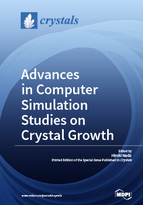Advances in Computer Simulation Studies on Crystal Growth
A special issue of Crystals (ISSN 2073-4352).
Deadline for manuscript submissions: closed (20 December 2016) | Viewed by 58643
Special Issue Editor
Interests: molecular simulations; potential models; crystal growth mechanisms; morphology controls; polymorphism; surfaces and interfaces; ice and water; biomineralization; antifreeze proteins; functional molecules
Special Issue Information
Dear Colleagues,
Crystals are indispensable in our daily lives and in our technology. Many kinds of crystallized products, such as salt, sugar, and fat crystals, are used in cooking. Electronic devices are made from semiconductor crystals. Crystals play an important role in both life and the global environment. Living organisms produce mineral crystals to keep biogenic activity. Snow and ice crystals formed in nature play a crucial role in climate change. For most of the topics related to crystals, which include the above examples, crystal growth is an important research area.
Owing to recent progress in the performance of computers, studies on crystal growth using comuputer simulations have become increasingly important. Using computer simulations, we can analyze and predict various aspects of crystal growth process, such as growth mechanisms and nucleation mechanisms, as well as the structures and dynamics of surfaces and interfaces, and pattern formation.
The current Special Issue of Crystals provides a unique forum for discussion and presentation of recent advances in computer simulation studies on crystal growth. Scientists and Engineers working in the related fields are invited to present their work in this issue.
The topics summarized under the keywords should be considered only as examples. The volume is open for any advanced topics related to Computer Simulations on Crystal Growth.
Dr. Hiroki Nada
Guest Editor
Manuscript Submission Information
Manuscripts should be submitted online at www.mdpi.com by registering and logging in to this website. Once you are registered, click here to go to the submission form. Manuscripts can be submitted until the deadline. All submissions that pass pre-check are peer-reviewed. Accepted papers will be published continuously in the journal (as soon as accepted) and will be listed together on the special issue website. Research articles, review articles as well as short communications are invited. For planned papers, a title and short abstract (about 100 words) can be sent to the Editorial Office for announcement on this website.
Submitted manuscripts should not have been published previously, nor be under consideration for publication elsewhere (except conference proceedings papers). All manuscripts are thoroughly refereed through a single-blind peer-review process. A guide for authors and other relevant information for submission of manuscripts is available on the Instructions for Authors page. Crystals is an international peer-reviewed open access monthly journal published by MDPI.
Please visit the Instructions for Authors page before submitting a manuscript. The Article Processing Charge (APC) for publication in this open access journal is 2600 CHF (Swiss Francs). Submitted papers should be well formatted and use good English. Authors may use MDPI's English editing service prior to publication or during author revisions.
Keywords
- Computer simulation
- Molecular dynamics simulation
- Monte Carlo simulation
- First-principles simulation
- Phase-field simulation
- Crystal growth
- Nucleation
- Surface and interface
- Pattern formation






